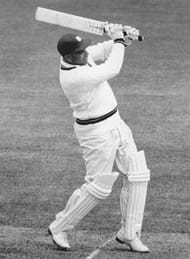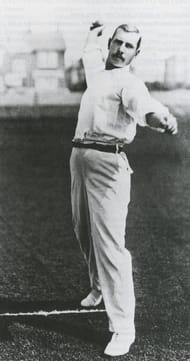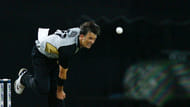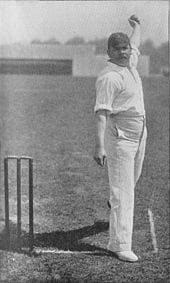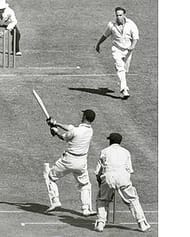This brings us to the selection of a wicketkeeper. Thirty years back I would have selected someone who was mercurial behind the stumps and efficient in front of them. Now, thanks to the likes of Gilchrist and Dhoni, I might have to go for someone who is the opposite – especially if I intend to play Bevan in the side. In case I do choose to place enough trust on my top six, I would go for a rank unknown. Had Steve Rhodes been a slightly better bat than he actually was, Alec Stewart might not have had a career. If England’s tour of India in ’88-’89 had gone to plan, Bumpy would have had a chance to don the Test gloves five years before he actually did. Even at 30, he showed his reflexes were intact by taking six catches and scoring 49 on debut. This was followed by his brilliant keeping to Devon Malcolm as the latter demolished South Africa at the Oval later that year. But, despite 49 victims in just 11 Tests, his batting remained sub-standard forcing the England selectors and me to have a rethink.
His “replacement” is much more famous and not a little bit because of his knighthood. Sir Clyde Walcott could walk into any Test team on the sheer dint of his batting but he could keep wicket as well and how. He played a third of his Test matches as designated keeper and managed to snare 38 batsmen including 11 stumpings most of which were of the bowling of the young spinners Gibbs and Ramadhin. This makes all the more sense if I am playing two and a half spinners. Walcott started out as an opener before juggling places with the other two Ws – Worrell and Weekes – in the middle order but he was a mighty fine lower middle order batsman too. The most memorable of his knocks at this positions was the historic 168 which helped West Indies beat England for the first time on English soil – an occasion which sparked celebrations the likes of which is not just rare but practically unimaginable today for any sporting event. Batting him at number 7 might be sacrilegious but I would tend to play him more often than not when Bevan is playing which means the two can swap places.
Which brings us to the bowlers. Before Syd Barnes, there was George Lohmann. If one was to summon the spirits of batsmen from the late 19th century and ask them who their greatest adversary was, not many would not take the name of Lohmann. Not that he was a speed merchant – in fact, far from it. Lohmann’s strength laid in seaming the ball both ways and he compounded the batsman’s misery by constantly experimenting with angle, flight and pace without compromising on his metronomic accuracy. He had a good eye for batting too and was brilliant in the slips. And rumours abound that most women at the turn of century went to watch England play only to see a “fair, blue-eyed, and handsome lad” play. Probably he should have been born a century later to have played more matches and won more female admirers.
His opening partner might be his anti-thesis as well. Shane Bond started out as a policeman but, a few years later, he was terrorising batsmen across the world with his extreme pace. Unlike his contemporary speedsters Akhtar and Lee, Bond had an action as smooth as a hot knife going through butter with no technical glitches. His career was cut short by multiple injuries which might have been avoided had he cut down on his pace. He refused to do so though which makes him an automatic candidate for my XI. Bond on his best was a sight to watch; it was a pity we got to see it so less.
Introducing spin into the attack would be Lohmann’s teammate Johnny Briggs. Briggs was a canny slow left arm orthodox but give him a slow wet turner and he could be lethal. Exactly half of his 118 wickets came as a first change bowler in 13 matches – these figures also include six 5 wicket hauls and three 10 wicket hauls. The most memorable of these would be the first time he got to bowl at this position. Australia were 45 for 1 when he started; when he finished with 5 for 29, they were 121 all out. He returned to take 6 wickets again in the second innings as Australia were well and truly trounced by an innings.
Finally my last choice would be a bowler who would hold fort in case Lohmann’s swing, Bond’s pace and Briggs’ wiles failed to mesmerise. With 109 wickets in 45 Tests, Ian Johnson isn’t the most obvious choice in a team chock-a-block with superstars but, as we have seen before, you need to have a stabilising influence to keep them grounded. It helped that Johnson was captain in 17 of the Tests he played although Australia lost most of those matches. The fault, though, was in the fact that the team he was leading was decidedly inferior to its predecessors. Johnson limited himself mostly to bowling as a fifth or even sixth option. His greatest successes, though, came from second change. In 15 Tests at that position he had picked up 57 wickets as opposed to 52 in the rest 30. Most of these successes came abroad – notably in West Indies and South Africa – where he probably felt more liberated as a bowler. This included his 5 for 34 in 1950 at Durban which helped Australia come up trumps against the home team.
The last task I have left to do is to select an option. Amongst the playing XI, only Umrigar and Johnson have captained their teams for a significant period of time. Even though it is of not of his own accord, Johnson’s miserable record as a leader does not inspire and I would rather have him as a visionary vice-captain to Umrigar’s leadership.
With that, I put the pen down or rather take my fingers off the keyboard. My team might be the Afghanistan of All-Time Test XIs but then every minnow has his day or two. And on his day, this David can upset many a Goliath (read: Wisden).
Follow IPL Auction 2025 Live Updates, News & Biddings at Sportskeeda. Get the fastest updates on Mega-Auction and cricket news
